March and early autumn are the perfect time to put on the flippers and goggles and visit our next door, under water neighbours. The Point Cook Marine Sanctuary is easy to get to. Either walk directly over the wetland or drive to the Point Cook Homestead and take a short stroll across the sand dune. The Marine Sanctuary is a protected refuge for all the sea’s flora and fauna. The quiet Sanctuary’s narrow sandy beach separates the land from the sea. Just off the coast a series of low basalt reefs rise from the sea floor; the remains of volcanic activity and lava flowing across the Western plains, thousands of years ago.
The combination of reef rock, sand and mud supports a fascinating range of marine life. The moment you dip below the water, an astonishing new landscape appears ready for exploration. The reef rock’s range of sea life, includes carpets of anemones, tubeworms, filamentous algae, with Sea Urchins bursting out of crevices and even in the darker corners, plentiful sponges grow.
Being a protected refuge, no fishing is allowed in the park and shoals of favourite fish such as Snapper, Whiting and Flathead are often seen. Small sharks and skates patrol the sea grass beds. In the late summer swarms of jellyfish pulsate over the reef cleaning the water of microscopic plants from this nutrient rich environment.
It would take a small book to describe this wonderfully life-packed marine sanctuary, so I thought I should simply detail some of the local native species that are relatively common around the park.
Firstly, a personal favourite ray, the harmless and approachable Fiddler Ray or Banjo Ray.
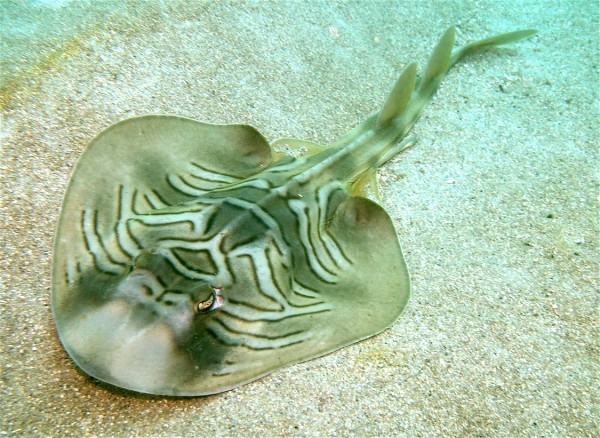 Eastern Fiddler Ray (Trygonorrhina fasciata)
Eastern Fiddler Ray (Trygonorrhina fasciata)
The Fiddler or Banjo Ray are regulars in the park. Their ornate markings camouflage them perfectly with the ripples in the sand and the reflections that the sun produces as it passes through the water over the motionless Fiddler, lying partially covered on the sea floor. Fiddler Rays possess physical characteristics of both sharks and skates. Their rounded body is formed by the fusion of the head and the pectoral fins, the snout is translucent, followed by a long tail which exhibits two dorsal fins. They are opportunistic bottom feeders, consuming a variety of shelled invertebrates, fish, crabs and worms which are crushed by their numerous short blunt teeth. The Fiddler Ray grows to a maximum length of 1.4 metres. The egg capsules are golden in colour, containing three embryos each. It gives birth to litters of four to six young per annual breeding cycle.
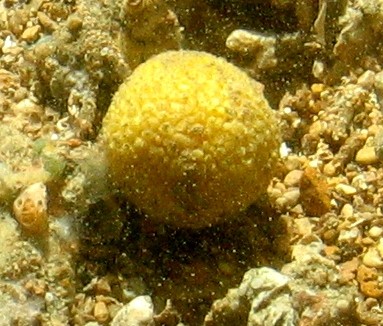 Golf Ball Sponge (Tethya) The Marine Park lies only a couple of decent par fives from SL Golf Course’s 16th tee. One of the first views for a snorkeler are these small 5cm sponges with shallow circular depressions, that can, remarkably, resemble a golf ball. It is one of the most common and abundant sponges on the Park’s intertidal and shallow reefs.
Golf Ball Sponge (Tethya) The Marine Park lies only a couple of decent par fives from SL Golf Course’s 16th tee. One of the first views for a snorkeler are these small 5cm sponges with shallow circular depressions, that can, remarkably, resemble a golf ball. It is one of the most common and abundant sponges on the Park’s intertidal and shallow reefs.
Sponges in the genus Tethya often exhibit budding propagules, a form of asexual reproduction whereby the parent sponge produces a stalk of spicules at its surface, terminating in a bud that detaches and floats away to become a separate individual. Golf Ball Sponge is the only member of the Tethya family group to be found in Victorian waters.
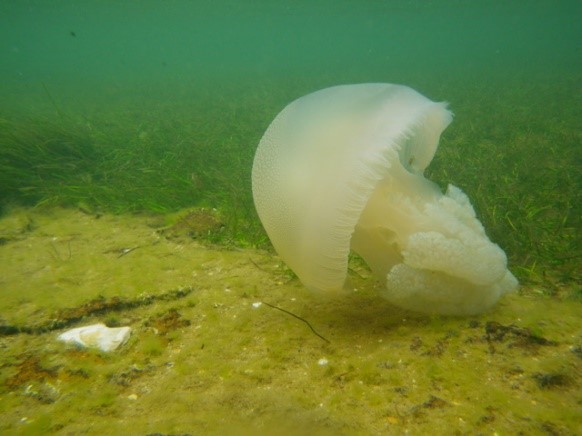 Blubber Jelly Fish (Catostylus mosaicus)
Blubber Jelly Fish (Catostylus mosaicus)
In the late summer the Blubber Jelly Fish becomes one of the most common species in the Marine Sanctuary. The Blubber's large 30–45 cm bell is a creamy white to blue colour. There is no obvious mouth on the underside, but there are small openings on each arm, through which food is passed to the stomach. The tentacles also have stinging cells that can capture tiny crustaceans and other plankton. For Snorkelers, the Blubber’s stings do not cause serious injury, only redness, a minor sting and itchy feeling. The Blubber Jelly Fish is edible and a very popular food in China, Korea and South East Asia.
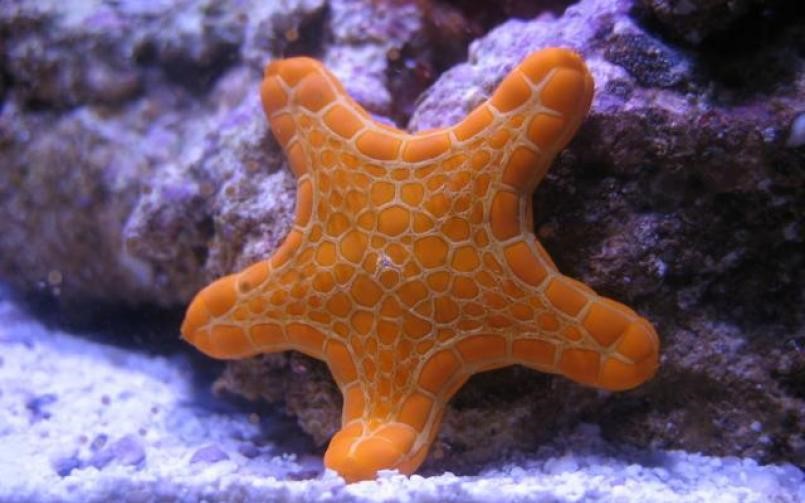 Biscuit Sea Star (Tosia australia) Snorkelling along the Marine Sanctuary, it is impossible not to be taken by the bright coloured Biscuit Starfish. It is a beautiful addition to the reef as it provides an immediate influx of colour, character, and activity. The Biscuit Starfish is a glowing bright red/orange starfish with distinctive interlocking polygonal shapes across its back, usually growing to an average of 8 centimetres in diameter. Biscuit Starfish are native to the shores of Victoria and scavenge the sea floor for meaty foods, including sponges, sea squirts, bryozoans and some algae.
Biscuit Sea Star (Tosia australia) Snorkelling along the Marine Sanctuary, it is impossible not to be taken by the bright coloured Biscuit Starfish. It is a beautiful addition to the reef as it provides an immediate influx of colour, character, and activity. The Biscuit Starfish is a glowing bright red/orange starfish with distinctive interlocking polygonal shapes across its back, usually growing to an average of 8 centimetres in diameter. Biscuit Starfish are native to the shores of Victoria and scavenge the sea floor for meaty foods, including sponges, sea squirts, bryozoans and some algae.
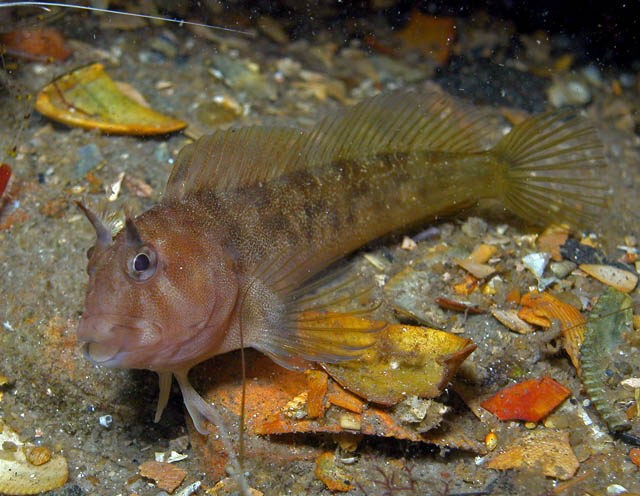 Southern Blenny (Parablennius)
Southern Blenny (Parablennius)
Growing to 8-10cm in length, the Southern Blenny is the Marine Sanctuary’s clown. Even their features have a comic effect with their large head, blunt snout with its steep profile, and an ‘over the top’ large frilled tentacle above each puzzling eye. Blennies can be seen poking their heads from holes and crevices, or even from discarded cans and bottles. Their eyes seemingly revolving in amusing surprise at seeing a large snorkeler approaching.
There are subtle differences between the Blenny sexes, with males having about six darker saddle-like markings above the midline of the body. Females have their saddles, broken up into a checkerboard pattern. Their breeding cycles are rapid, up to five in a year with the female often laying their eggs in empty mollusc shells. The eggs take about three weeks to hatch. During this time the males are sometimes seen guarding and fanning the eggs.
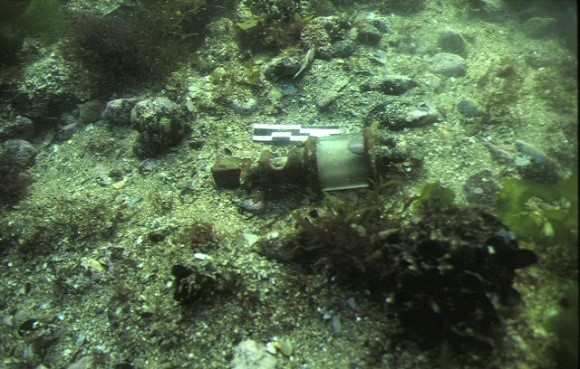 Henrietta wreckage on Point Cook Reef Finally, no Marine Sanctuary or Snorkeler’s Paradise can be without a shipwreck and our Marine Sanctuary not only has one but two - the Henrietta and the Diane.
Henrietta wreckage on Point Cook Reef Finally, no Marine Sanctuary or Snorkeler’s Paradise can be without a shipwreck and our Marine Sanctuary not only has one but two - the Henrietta and the Diane.
The Diane was a 40-foot wooden cutter, a Bay and coastal trader with runs between Launceston, Western Port, Geelong, Melbourne and Port Fairy. She sprang a leak on Saturday 23 December 1877, off Point Cook. For the safety of those on board she was run aground on the Point Cook Reef. The cutter was laden with firewood and was owned by R. Owens of Williamstown. A small quantity of wreckage still remains on the reef’s floor.
Our second ship wreck the Henrietta, was a 114 foot 'Bluenose' or Nova Scotia schooner, built in 1915 for Grand Banks fishery off Cape Cod, Newfoundland, had fished for 20 years, from its home port Truro. Allegedly used in the film 'Captains Courageous', but the details below from the Victorian Heritage data base, could be the outline for a movie of great characters and dramatic action:
“The Henrietta left Geelong before dawn on the 29th September 1940, in a SW breeze that soon strengthened. When well under way crew found no chart of Bay was on board (previously removed by a pilot for updating and not returned). Ran aground, with tide falling, on end of reef that runs out from Point Cook for more than 1 mile, buoy marking end of reef not seen in bad weather conditions. Schooner was seen to strike and Ports & Harbors tug Victory arrived to pull schooner into deeper water - attempt unsuccessful. Crew decided to stay on board overnight to await another salvage effort at flood tide. Huge seas during night swept away dories. Emergency flares not seen. Crew and ship's cat finally rescued the next day at 12 30 pm by Victory, but kittens drowned.
Bought by Sawyer, an adventurous American master mariner, and his wife (an Australian) in 1935, they had brought Henrietta to Melbourne in 1938 while on a world cruise but had been forced to cancel part of voyage because of outbreak of war. While on a trip to the Great Barrier Reef, the Henrietta recorded 10 previously uncharted navigable passes in the reef. Sawyer had enlisted in July 1940 in RAAF. Schooner had been lying at Geelong for some months and was being taken to Williamstown for overhaul by the airmen on weekend leave. Sawyer killed in air crash on Blue Mountains a few months later - the same weekend that another storm smashed up some of Henrietta’s remains. His ashes were scattered by crew members Hilder and Charlton over the scene of wreck.”
Two Shipwrecks and the amazing variety of marine life, you simply have to pull your flippers and snorkel out of the cupboard and pop next door for a peep at the action under the waves at our Marine Sanctuary.